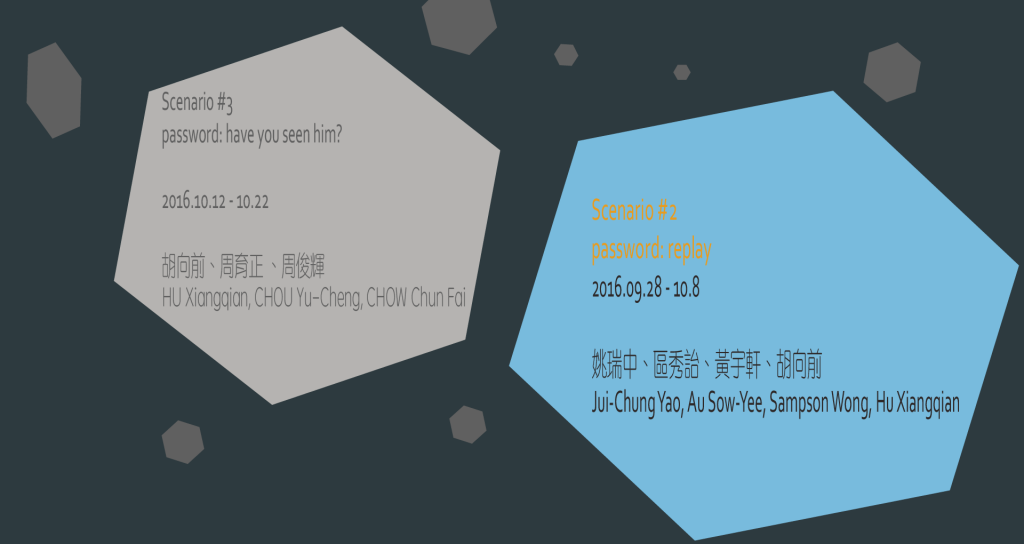For English, please scroll down.
有一股底蘊,於場景二
四。徑。蹈
迴了一圈過,然後?打掉重練
「上升」、「循環」、「上升」、「循環」… 每一個場景,都鋪陳著一個引子。是次,這引子則自胡向前的六頻幕錄像作品《再造米開朗基羅》中那不斷溢出既規律且制式的口號聲。暨首檔場景啟動「肖像擺」的運動模式後,在第二回合的力道之下,一切回歸古老式命題。見下。
一個人怎樣才能成為一個藝術家。環境?空間?還是個人意志力的體現?
這些問題可能並沒有一個明確的答案,更可能應該是以上的一個綜合吧。
作為展中已開跑且接續推演的場景之一,依舊可見的是:現場內這一桌打麻將的聚眾、那一處聽賞玩樂的交際以及另一角落泡湯、釣魚或游泳的個人閒娛,在分不清幾分現實幾分虛擬的環絡中這一群人以個體 / 集體特徵的共構拉出一道特定的時間軸,這是自姚瑞中筆下《週休八日圖》的原班人馬所上演著穿越場景之群像對話,沿著時敘橫切面地探看台灣在地藝術近史中不斷交疊消融的文化生產等高線。而面對巨幅人物山水畫面的另一頭及散落展場中其他各處的一組映像畫面則是相對單薄的兩個人 – 藝術家以及他的學徒,演的戲碼是:藝術家養成計畫。此為胡向前的作品《再造米開朗基羅》,作品中提出這樣的問題:一個畫家可以教他(她)的助手畫畫,一個雕塑家可以教他(她)的助手做雕塑。那,一個行為藝術家是否可以教他(她)的助手做行為?並教他(她)的助手進而成為一位藝術家?在不斷練習的過程中且分不清有觀眾還是沒觀眾的現場之間,以透明的權力結構拉開新的關係結構,目睹著用時間和空間對「人」進行「雕塑」。
「當代藝術算是一個年輕人嗎?」「對呀!它畢竟也沒多少時間。比起幾千年的油畫,它還算是個年輕人吧!」(節自《再造米開朗基羅》師與徒的對話)
再探全景山水的側翼,區秀詒則以《If the Party Goes On》作為揭開倒敘的線頭,「那場派對始終等不到主人,派對一切可能的想像諸如各式夥伴、聯盟也始終來不及發生。」其以虛構史的敘事解碼冷戰歷史章節下的權力佈局。而《If the Party Goes On. 序曲:To the Party》作為作品的前導,則藉影像殘篇、手稿與生命傳記等三組交錯線索的呈現,切開資本 – 影像之間的場域,拉出一個觀看的提示距離 – 歷史是過去的未來。轉身進探匿於地下場景且同樣緊密呼應著漫流於歷史、未來、權力、佈局等敘事座標上的另一參照,則是由黃宇軒所帶來的參與式情境作品《海報站:明日香港,明日台灣》。從收集、檔案化、重組到再製,「雨傘運動視覺庫存計畫」的影本文件呈現於展覽現場中,以開放自助複印平台並也期待迎與後加入的在地太陽花運動文件一同捏塑抵禦語境,攪動跨地域脈絡對話。
通過場景二內點、線、面之間的撐力張結,穿透史敘結構中的異質滲入。如拓撲物件的莫比烏斯帶,運作之下僅產生一種單義,即無窮大符號。
#拼貼 #機制挑釁 #敘事的前戲
姚瑞中
姚瑞中的創作關懷著人類處境和歷史的荒謬,以不同的形式和媒體進行各種具有政治性的批判和諷刺性的暗喻。他更在自己長期的實踐裡,體現了高度的社會責任感,揭露社會性的不公義並且執著於藝術史及檔案保存的重要性。目前工作與生活於台北。
區秀詒
在區秀詒的影像語彙中藉其深究田調訪、文獻考所集結之生命經驗,以歷史語境的爬梳,反映於高度思辨的音像部署。其創作上的美學探討,一是對影像(史)生成機制和其幽靈的關注,以機械式電影放映機而作的現場電影;二是以錄像、觀念、裝置等混合形式,探討和擴延影像與影像製造以及政治、權力之間的關係。目前工作與生活於台北。
黃宇軒
跨足於藝術創作、策展實踐及文字書寫,並同時致力於跨界的都市研究。其計畫往往以扎根在地的政治解放精神,關注都市理論、空間、權力與自由等問題。他過去幾年間共同創辦了諸多團體,包括雨傘運動視覺庫存。目前工作與生活於香港,並在香港演藝學院任教人文學科。
胡向前
胡向前的行為表演以嘲諷荒誕的語法展開對於社會政治環境機制的批判,創造異質的日常領地,探尋自我存在之證據,其細膩精準的操作直逼表演和現實的臨界點,產生新的連貫性和互為後設的可能:表演性自身所載動的政治力量成為超越和啓發現實的途徑,幽默地取消了之間的疆界並展開重新凝視真實的條件。目前工作與生活於廣州與北京。
There is a lyric for four acts and four faces.
Then, leave it all behind.
Zero.
“Up”, “Circulate”, “Up”, “Circulate”… is the overture for the current scenario from HU Xiangqian’s work. After the first movement of Portrait Portrait, the second scenario adds his voice to put forward a classic proposition: How to become an artist? Is it the push from the environment, surroundings or individual’s mind? Perhaps there is no definite answer. Probably it is an integration of all of these factors.
A group sitting around a mahjong table, a gang from the music scene, and people spread around the landscape bathing in the hot spring, fishing or swimming. This is the original cast from the first scenario depicted in Eight Days a Week and still continuing to play. They provide a certain continuity and timeline through YAO Jui-Chung’s painting where individual/collective characteristics blur the context between the real and the imaginary. To look at the artistic cultural production, it maps the overlapping contours of a brief history of the Taiwanese art scene.
Opposite Yao’s large-scale work there is a relatively smaller scene playing out: two characters, the artist and his assistant, in one story about a ‘becoming artist’ plan. This is Reconstructing Michelangelo by artist HU Xiangqian. Through his six-channel video the artist brings up the following questions: A painter can train his or her assistant to paint, a sculptor can train his or her assistant to make sculptures. But, can a performance artist teach his or her assistant to act? Moreover, to become an artist? Through the studio exercises and stage rehearsals, HU seeks to build a new relationship from the seemingly transparent power structure between artist and assistant. In their conversations and actions, the work shows how to sculpt an individual through time and space:
“Do you think contemporary art is still very young?” “Yes, It’s still quite young, compared to painting, for instance.”
On the other side of the hill: “The host never showed up at the party and none of the imagined partners, associates or collaborators ever appeared, either.” This is the historical event that inspires If the Party Goes On by Au Sow-Yee, a work that replays the history of the film industry as a fictional narrative to decipher Cold War political power. By presenting moving image, a draft script and a fictional biography, If the party goes on. Prelude: To the Party is a clue to guide us towards the coming work. Taking the line a history is a past of future the artist intends to open up the hidden contextual layers between capitalism and film.
Underground, a poster studio is in operation, archiving and representing documents from the Umbrella and Sunflower Movements. This is the Poster Station: Hong Kong’s Future, Taiwan’s Future by artist Sampson Wong where visitors are invited to copy, combine and distribute the political material, to build resistance and agitate between the two movements.
These four faces of this scenario, while existing in the heterogeneity of historical narratives, speak together, a mobius band turning back infinitely.
#collage #institutional provocation #foreplay of narrative
YAO Jui-Chung
Yao is an artist whose practice has been consistently sensitive to human conditions and the absurdity of history throughout its various forms and media. Critical and often sarcastic metaphors act to politically charge his work that expose injustice and question the social responsibility of archives and art history. Yao lives and works in Taipei.
AU Sow-Yee
AU Sow-Yee’s work takes two approaches rooted in moving images. One is her continuing interest in image-making mechanism and its ghost, creating live cinema performances using mechanical film projectors. Second is to question, explore as well as expand the relation between images, image-making, politics and power, through video installations and other mediums. Through her artistic language and dialectical approach to audio-visual “mapping”, she depicts the accumulation of a ‘bio-archive’ from her investigation into historical contexts. Au lives and works in Taipei.
Sampson WONG
Wong works as an artist, curator and writer, following his research interests in trans-urbanist projects. He reconsiders the local conditions with new political liberation spirit, and explores issues about urbanism, space, power and freedom. He has co-founded many groups, including the Umbrella Movement Visual Archive. Wong lives and works in Hong Kong, and currently teaches in Hong Kong Academy of Performing Art.
HU Xiangqian
HU Xiangqian is known for performances that create unusual everyday situations. Through a theatre of the absurd he directs the evidence of existence as a critical act directed towards social and political institutions. Through a precise and sophisticated manipulation of the boundary between performance and reality he creates new contiguities and self-reflections. The political power of his work is based in these short circuits that invalidate the limitations of perception. Hu lives and works in Guangzhou and Beijing.


